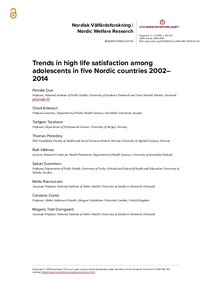Trends in high life satisfaction among adolescents in five Nordic countries 2002–2014
Candace Currie; Thomas Potrebny; Mogens Trab Damgaard; Raili Välimaa; Sakari Suominen; Charli Eriksson; Mette Rasmussen; Torbjørn Torsheim; Pernille Due
https://urn.fi/URN:NBN:fi-fe2021042822175
Tiivistelmä
Life satisfaction is an important indicator when assessing positive mental health aspects in populations, including among adolescents. The aim of this study was to investigate trends over time in prevalence of high life satisfaction among adolescents from five Nordic countries: Denmark, Iceland, Finland, Norway and Sweden.
We used data from four waves of the Health Behaviour in School-Aged Children study from 2002, 2006, 2010 and 2014 (n=109,847). HBSC is a school-based study examining social circumstances, health and health behaviour among 11-, 13- and 15-years olds every four years in many European and North American countries. The Cantril Ladder, an 11-step visual analogue scale, was used as the measure of life satisfaction, and was dichotomised into two groups: high life satisfaction (scoring 9 or 10 on the scale) and medium/low life satisfaction (scoring <9).
Over the 12-year period studied, between 28.6 and 44.8% of adolescents in the five countries rated their life satisfaction as high. Relatively large changes in prevalence levels occurred at the country level over the period. Denmark and Finland showed a steady, significant decline in the prevalence of high life satisfaction over the years. Iceland showed the highest prevalence in 2010. Norway and Sweden showed similar development until 2010, followed by a clear increase for Norway and a sharp decline in adolescent high life satisfaction for Sweden up until 2014. In all countries, high life satisfaction was most prevalent in 11-year- olds and least prevalent in almost all surveys among 15-year-old girls.
Kokoelmat
- Rinnakkaistallenteet [18789]
